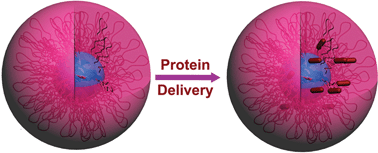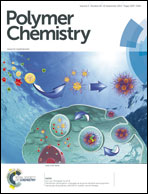Reverse micelles based on β-cyclodextrin-incorporated amphiphilic polyurethane copolymers for protein delivery†
Abstract
A series of amphiphilic polyurethane (PU) copolymers were synthesized by a condensation reaction of poly(ethylene glycol) (PEG) of different molecular weights and 1,6-hexamethylene diisocyanate (HDI), with/without end-capped heptakis(2,6-di-O-methyl)-β-cyclodextrin (DM-β-CD). Their chemical structures were characterized by Fourier transform infrared (FT-IR) spectroscopy and proton nuclear magnetic resonance (1H-NMR) spectroscopy. Their molecular weights, thermal properties and crystallization properties were investigated using gel permeation chromatography (GPC) and differential scanning calorimetry (DSC), respectively. A model protein, bovine serum albumin (BSA), was encapsulated into the PU reverse micelles (RMs) with/without DM-β-CD entities using an emulsification method in dichloromethane (DCM), and then further transferred in biocompatible oil, i.e., ethyl oleate. The diameter of RMs in DCM decreased from 180–480 nm to 100–280 nm upon heating, as determined by dynamic light scattering (DLS), and it was spherical in shape, as observed using a scanning electron microscope (SEM). The encapsulation efficiency (EE) and loading capacity (LC) of BSA in the RMs composed of DM-β-CD-containing PUs were much higher than those without DM-β-CD. In vitro release studies showed that the release rate of RMs of DM-β-CD-containing PUs was faster than their counter parts without DM-β-CD. Interestingly, among all the RMs in the present study, the RMs of DM-β-CD-containing PUs composed of the irregular segments of both PEG1000 and PEG2000 exhibited the highest EE and LC, and the fastest release rate of its cargo. These results highlight the ability of RMs of proper PU composition to act as carriers for protein in an oleous phase with good EE and proper release behavior, paving a new way for the application of PU-based RMs in protein or peptide delivery.


 Please wait while we load your content...
Please wait while we load your content...